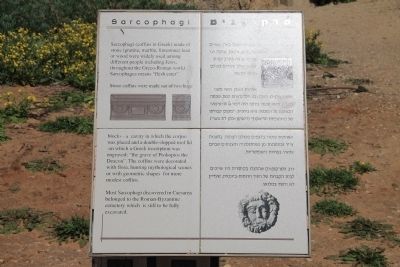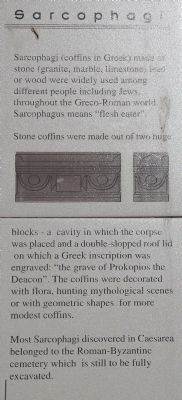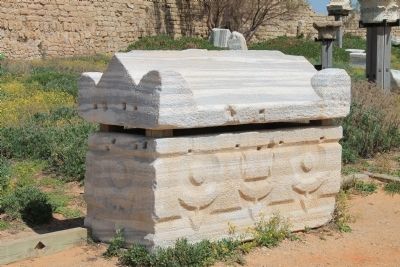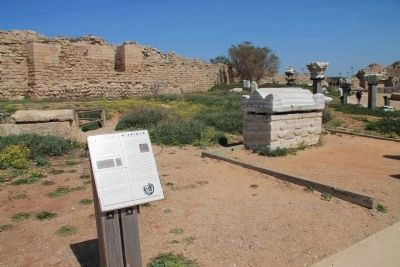Caesarea, Haifa District, Israel — West Asia (the Levant in the Middle East)
Sarcophagi
Stone coffins were made out of two huge blocks - a cavity in which the corpse was placed and a double-slopped roof lid on which a Greek inscription was engraved: "the grave of Prokopios the Deacon". The coffins were decorated with flora, hunting mythological scenes or with geometric shapes for more modest coffins.
Most Sarcophagi discovered in Caesarea belonged to the Roman-Byzantine cemetery which is still to be fully excavated.
Topics. This historical marker is listed in these topic lists: Anthropology & Archaeology • Cemeteries & Burial Sites.
Location. 32° 29.789′ N, 34° 53.423′ E. Marker is in Caesarea, Haifa District. Marker can be reached from Kvish HaTe'atron just west of Rothschild, on the left when traveling west. This historical marker is located in the Caesarea Maritima National Park, very near to the western end of Kvish HaTe'atron Street. The marker is situated along a walkway that is beyond the Kvish HaTe'atron Street entrance, to the archaeological park, on the right hand side of the walkway. Touch for map. Touch for directions.
Other nearby markers. At least 8 other markers are within walking distance of this marker. Column Capitals (a few steps from this marker); The Promontory Palace (within shouting distance of this marker); The Theater (within shouting distance of this marker); Architectural Elements (within shouting distance of this marker); A Collection of Architectural Artifacts (within shouting distance of this marker); Power and Control (within shouting distance of this marker); King Herod's Hippodrome (within shouting distance of this marker); Dedicatory Inscription (about 90 meters away, measured in a direct line). Touch for a list and map of all markers in Caesarea.
Related markers. Click here for a list of markers that are related to this marker. To better understand the relationship, study each marker in the order shown.
Also see . . .
1. Caesarea Maritima. This is a link to information provided by Wikipedia, the free encyclopedia. (Submitted on April 17, 2013, by Dale K. Benington of Toledo, Ohio.)
2. Caesarea Maritima - Cornell University. This is a link to information provided by Cornell University. (Submitted on April 17, 2013, by Dale K. Benington of Toledo, Ohio.)
3. Vitruvius. This is a link to information provided by, Wikipedia, the free encyclopedia. (Submitted on April 17, 2013, by Dale K. Benington of Toledo, Ohio.)
4. De architectura. This is a link to information provided by Wikipedia, the free encyclopedia. (Submitted on April 17, 2013, by Dale K. Benington of Toledo, Ohio.)
Credits. This page was last revised on January 1, 2024. It was originally submitted on April 17, 2013, by Dale K. Benington of Toledo, Ohio. This page has been viewed 651 times since then and 14 times this year. Photos: 1, 2, 3, 4, 5. submitted on April 17, 2013, by Dale K. Benington of Toledo, Ohio.




